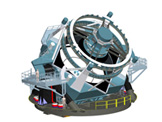Rubin Observatory Legacy Survey of Space and Time (LSST)
The Rubin Observatory Legacy Survey of Space and Time (LSST) is designed to survey the entire observable sky every three nights, and repeat the three-night cycle for a period of ten years. The Rubin Observatory is unique among large telescopes (those with 8-meter class primary mirrors) in that the telescope will have a very wide 3.5-degree field of view. A 3200 megapixel prime focus digital camera will take 15-second exposures every 17 seconds. The camera is expected to take more than 200,000 pictures per year when it begins operations at an elevation of almost 2700 meters on the El Penon peak in northern Chile.
The Rubin Observatory LSST will provide an enormous amount of data (approximately 15 terabytes of data per night) for scientific research, and will address some of the most important questions about the structure and evolution of the universe. What is the “dark energy” that is responsible for the acceleration of cosmic expansion? What is “dark matter” and how does it affect the formation of stars, galaxies, and larger structures in the universe? Are there other kinds of explosive phenomena, such as supernovae, in the universe that have not yet been discovered? The Rubin Observatory LSST will also provide data to answer questions about our solar system and Milky Way galaxy. For example, are there potentially hazardous asteroids that could someday collide with Earth? What is the nature of the outer regions of the solar system? How did the Milky Way form and evolve over time?
The Rubin Observatory LSST is supported by the National Science Foundation (NSF), Department of Energy (DOE), and private donations. DOE participation is focused on developing the LSST Camera, with the DOE Project Office located at the SLAC National Accelerator Laboratory. Other DOE laboratories are institutional members of the Rubin Observatory Project. Fermilab is one of these laboratories and with the laboratory’s history in the Sloan Digital Sky Survey (SDSS) and Dark Energy Survey (DES), scientists at Fermilab are looking forward to using Rubin Observatory LSST data to study Dark Energy and Dark Matter. The scientific techniques that they will use include the study of galaxy clusters, measurements of weak lensing of distant galaxies, measurements of baryon acoustic oscillations, observations of distant supernovae, and studies of the most dark-matter-dominated galaxies.
Team Members
- Jim Annis
- Elizabeth Buckley-Geer
- Alex Drlica-Wagner
- Ken Herner
- Steve Kent
- Nikolay Kuropatkin
- Huan Lin
- Eric Neilsen
- Douglas Tucker
- Brian Yanny










